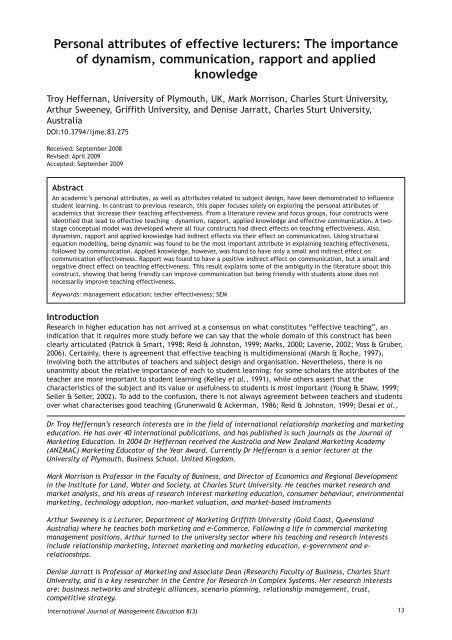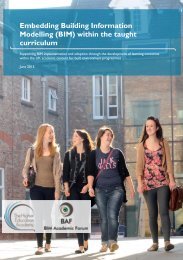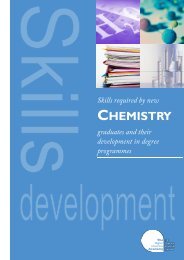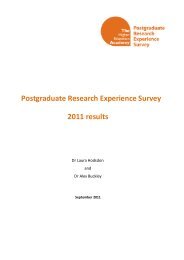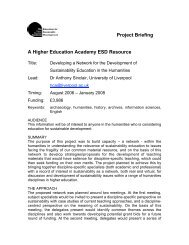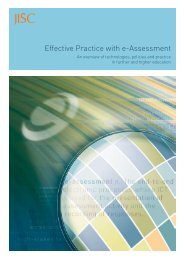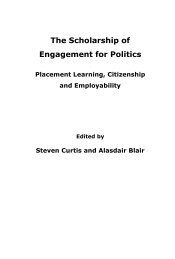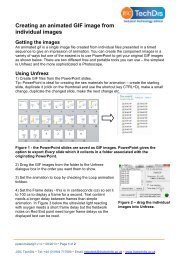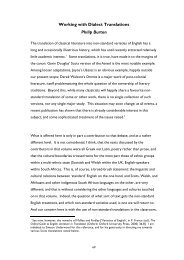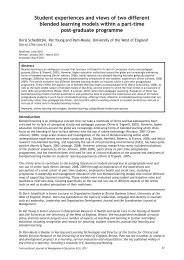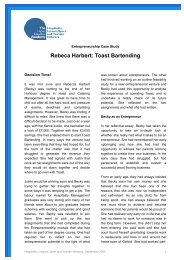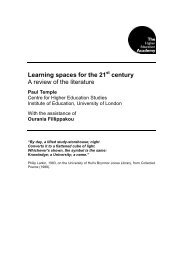Personal attributes of effective lecturers - Higher Education Academy
Personal attributes of effective lecturers - Higher Education Academy
Personal attributes of effective lecturers - Higher Education Academy
Create successful ePaper yourself
Turn your PDF publications into a flip-book with our unique Google optimized e-Paper software.
<strong>Personal</strong> <strong>attributes</strong> <strong>of</strong> <strong>effective</strong> <strong>lecturers</strong>: The importance<br />
<strong>of</strong> dynamism, communication, rapport and applied<br />
knowledge<br />
Troy Heffernan, University <strong>of</strong> Plymouth, UK, Mark Morrison, Charles Sturt University,<br />
Arthur Sweeney, Griffith University, and Denise Jarratt, Charles Sturt University,<br />
Australia<br />
DOI:10.3794/ijme.83.275<br />
Received: September 2008<br />
Revised: April 2009<br />
Accepted: September 2009<br />
Abstract<br />
An academic’s personal <strong>attributes</strong>, as well as <strong>attributes</strong> related to subject design, have been demonstrated to influence<br />
student learning. In contrast to previous research, this paper focuses solely on exploring the personal <strong>attributes</strong> <strong>of</strong><br />
academics that increase their teaching <strong>effective</strong>ness. From a literature review and focus groups, four constructs were<br />
identified that lead to <strong>effective</strong> teaching – dynamism, rapport, applied knowledge and <strong>effective</strong> communication. A twostage<br />
conceptual model was developed where all four constructs had direct effects on teaching <strong>effective</strong>ness. Also,<br />
dynamism, rapport and applied knowledge had indirect effects via their effect on communication. Using structural<br />
equation modelling, being dynamic was found to be the most important attribute in explaining teaching <strong>effective</strong>ness,<br />
followed by communication. Applied knowledge, however, was found to have only a small and indirect effect on<br />
communication <strong>effective</strong>ness. Rapport was found to have a positive indirect effect on communication, but a small and<br />
negative direct effect on teaching <strong>effective</strong>ness. This result explains some <strong>of</strong> the ambiguity in the literature about this<br />
construct, showing that being friendly can improve communication but being friendly with students alone does not<br />
necessarily improve teaching <strong>effective</strong>ness.<br />
Keywords: management education; techer <strong>effective</strong>ness; SEM<br />
Introduction<br />
Research in higher education has not arrived at a consensus on what constitutes “<strong>effective</strong> teaching”, an<br />
indication that it requires more study before we can say that the whole domain <strong>of</strong> this construct has been<br />
clearly articulated (Patrick & Smart, 1998; Reid & Johnston, 1999; Marks, 2000; Laverie, 2002; Voss & Gruber,<br />
2006). Certainly, there is agreement that <strong>effective</strong> teaching is multidimensional (Marsh & Roche, 1997),<br />
involving both the <strong>attributes</strong> <strong>of</strong> teachers and subject design and organisation. Nevertheless, there is no<br />
unanimity about the relative importance <strong>of</strong> each to student learning: for some scholars the <strong>attributes</strong> <strong>of</strong> the<br />
teacher are more important to student learning (Kelley et al., 1991), while others assert that the<br />
characteristics <strong>of</strong> the subject and its value or usefulness to students is most important (Young & Shaw, 1999;<br />
Seiler & Seiler, 2002). To add to the confusion, there is not always agreement between teachers and students<br />
over what characterises good teaching (Grunenwald & Ackerman, 1986; Reid & Johnston, 1999; Desai et al.,<br />
Dr Troy Heffernan’s research interests are in the field <strong>of</strong> international relationship marketing and marketing<br />
education. He has over 40 international publications, and has published is such journals as the Journal <strong>of</strong><br />
Marketing <strong>Education</strong>. In 2004 Dr Heffernan received the Australia and New Zealand Marketing <strong>Academy</strong><br />
(ANZMAC) Marketing Educator <strong>of</strong> the Year Award. Currently Dr Heffernan is a senior lecturer at the<br />
University <strong>of</strong> Plymouth, Business School, United Kingdom.<br />
Mark Morrison is Pr<strong>of</strong>essor in the Faculty <strong>of</strong> Business, and Director <strong>of</strong> Economics and Regional Development<br />
in the Institute for Land, Water and Society, at Charles Sturt University. He teaches market research and<br />
market analysis, and his areas <strong>of</strong> research interest marketing education, consumer behaviour, environmental<br />
marketing, technology adoption, non-market valuation, and market-based instruments<br />
Arthur Sweeney is a Lecturer, Department <strong>of</strong> Marketing Griffith University (Gold Coast, Queensland<br />
Australia) where he teaches both marketing and e-Commerce. Following a life in commercial marketing<br />
management positions, Arthur turned to the university sector where his teaching and research interests<br />
include relationship marketing, Internet marketing and marketing education, e-government and erelationships.<br />
Denise Jarratt is Pr<strong>of</strong>essor <strong>of</strong> Marketing and Associate Dean (Research) Faculty <strong>of</strong> Business, Charles Sturt<br />
University, and is a key researcher in the Centre for Research in Complex Systems. Her research interests<br />
are: business networks and strategic alliances, scenario planning, relationship management, trust,<br />
competitive strategy.<br />
International Journal <strong>of</strong> Management <strong>Education</strong> 8(3)<br />
13
2001; Faranda & Clarke, 2004). Considering the lack <strong>of</strong> clarity in the literature, this study sought to explore<br />
the crucial personal components <strong>of</strong> an <strong>effective</strong> lecturer. Using the data collected from a survey <strong>of</strong> oncampus<br />
under-graduate marketing students, a conceptual model is developed and tested using structural<br />
equation modelling (SEM).<br />
The paper proceeds as follows. Firstly a literature review is undertaken <strong>of</strong> previous research exploring<br />
lecturer <strong>effective</strong>ness. As the study investigates the personal <strong>effective</strong>ness <strong>of</strong> management <strong>lecturers</strong>,<br />
specifically in marketing, the predominate body <strong>of</strong> literature examined explores studies within this discipline.<br />
However, research outside the field <strong>of</strong> general management education is also considered. Next, the<br />
methodologies used in this study are described, identifying and justifying both the qualitative and<br />
quantitative techniques employed. After that, findings from the qualitative focus groups are presented.<br />
These findings, coupled with the review <strong>of</strong> literature, form the bases for the development <strong>of</strong> the conceptual<br />
model. The findings from the structural equation modelling <strong>of</strong> the conceptual model are then presented. This<br />
is followed by implications for educators, including a set <strong>of</strong> strategies for improving teaching <strong>effective</strong>ness.<br />
The paper finishes with conclusions, limitations and ideas for further research.<br />
Literature review<br />
Over the years, numerous studies have explored the concept <strong>of</strong> the <strong>effective</strong> lecturer. As stated previously,<br />
the concept <strong>of</strong> an <strong>effective</strong> lecturer is an illusive one. Consequently, in this paper an <strong>effective</strong> lecturer<br />
relates to an academic who can enhance students’ learning, someone who has a range <strong>of</strong> characteristics and<br />
skills that improve the knowledge <strong>of</strong> the student cohort. Therefore, this study attempts to identify and<br />
measure the drivers inherent in <strong>lecturers</strong> that increase student learning in a subject.<br />
Whilst the educational literature has identified both personal and organisational <strong>attributes</strong> <strong>of</strong> <strong>effective</strong><br />
<strong>lecturers</strong>, this paper concentrates on the personal <strong>attributes</strong>. Indeed, Patrick and Smart (1998) called for<br />
further research into academics’ personal qualities and suggest that “perhaps the whole domain <strong>of</strong> <strong>effective</strong><br />
teaching could be captured by the inclusion <strong>of</strong> the innate qualities <strong>of</strong> the teacher, thereby contributing to a<br />
clearer understanding <strong>of</strong> teacher <strong>effective</strong>ness” (p. 168). In the general pedagogical literature there have<br />
been frequent attempts to identify the <strong>attributes</strong> <strong>of</strong> an <strong>effective</strong> lecturer. Ramsden (1992), in his seminal<br />
work, identified enthusiasm, communication skills, ability to develop rapport and well structured content as<br />
key constructs that contribute to students’ attitudes towards learning. Likewise, Lacoss (2000) found that<br />
communication skills, use <strong>of</strong> appropriate examples, availability <strong>of</strong> the lecturer, and rapport developed<br />
between the student and the lecturer, helped to enhance student learning. As can be seen from both <strong>of</strong> the<br />
studies above, the importance <strong>of</strong> the personal <strong>attributes</strong> <strong>of</strong> the lecturer tend to outweigh the subject-specific<br />
<strong>attributes</strong> in determining student learning.<br />
As personal <strong>attributes</strong> are the key variables examined, this research is anchored by the attribution theory<br />
(Heider, 1958). Fundamentally, attribution is the way in which one person makes inferences about the<br />
motives underlying others behaviour (Kelly & Michela, 1980): a cognitive process people use to assign an<br />
underlying explanation or cause to an observation made (Kelly, 1967). Theorists in this arena specify the way<br />
people interact with their social environment (Freedman, 1984). Consequently, a review <strong>of</strong> the literature was<br />
undertaken to isolate the key personal <strong>attributes</strong> that contribute to student learning. Four main individual or<br />
personal constructs were identified in the educational literature - dynamic delivery, rapport, applied<br />
knowledge and clear communication – and these are considered in turn.<br />
Dynamic delivery is the ability to motivate students through being enthusiastic and entertaining, for example<br />
the use <strong>of</strong> humour (Patrick & Smart, 1998; Young & Shaw, 1999; Pozo-Munõz et al., 2000). The concept is<br />
verging on the entertainment value <strong>of</strong> the lecturer (Jin, 2000). In a study published in The International<br />
Journal <strong>of</strong> Management <strong>Education</strong>, Jin (2000) identified words to describe the dynamism <strong>of</strong> a lecturer as<br />
interesting, charismatic and humorous. Dynamism has previously been directly linked to <strong>effective</strong> lecturing:<br />
Guolla (1999), Shevlin et al. (2000), and Seiler and Seiler (2002) found large and moderate effects on student<br />
satisfaction and learning. Similarly, Young and Shaw (1999) found that the ability to motivate students was<br />
one <strong>of</strong> the most discriminating variables between quality teachers and poor teachers. Further, Jin (2000) and<br />
Shevlin et al. (2000) identified a positive link between dynamism and communication, a result consistent with<br />
the qualitative findings <strong>of</strong> Faranda and Clarke (2004).<br />
The second characteristic <strong>of</strong> an <strong>effective</strong> lecturer related to the rapport developed with students. Two<br />
definitions <strong>of</strong> rapport are “the ability to maintain harmonious relationships based on affinity for others”<br />
(Faranda & Clarke, 2004, p. 274) and “a close harmonious relationship founded on mutual trust” (Weitz et<br />
al., 2007, p. 225). Words that researchers have used to describe this construct include care, respect,<br />
approachability, concern, empathy, fairness and friendliness (see Table 1). A number <strong>of</strong> these studies<br />
investigated the importance <strong>of</strong> rapport on teaching <strong>effective</strong>ness. Granitz et al. (2009) identified a range <strong>of</strong><br />
benefits <strong>of</strong> enhanced rapport for students, including greater learning and higher levels <strong>of</strong> involvement.<br />
Clayson and Haley (1990) and Marks (2000) found that rapport has almost double the effect <strong>of</strong> any other<br />
14<br />
International Journal <strong>of</strong> Management <strong>Education</strong> 8(3)
construct on student learning whereas other studies have found the effect to be similar or smaller than other<br />
constructs (Guolla, 1999; Young & Shaw, 1999). Thus the majority <strong>of</strong> previous studies have found that rapport<br />
positively influences teaching <strong>effective</strong>ness, though there is some uncertainty about the magnitude <strong>of</strong> the<br />
likely effect. Further, there is evidence to support the link between rapport and enhanced communication.<br />
For example, Conant et al. (1988), Kelley et al. (1991), and Faranda and Clarke (2004) found links between<br />
rapport and communication; Smart et al. (2003) found links between respect and communication; and Young<br />
and Shaw (1999) found links between empathy and communication.<br />
Another important construct identified is a lecturer’s overall subject knowledge (Stringer & Irwing, 1998),<br />
with strong emphasis on “real world knowledge”, in other words an ability to integrate the theory with<br />
stimulating situations and relevant examples from the business world. Specifically, this construct relates to<br />
the <strong>lecturers</strong> knowledge, expertise and real-world perspective. Whilst this variable would seem critical in the<br />
<strong>attributes</strong> <strong>of</strong> an <strong>effective</strong> lecturer, it has received limited attention in the literature. One study by Clayson<br />
and Haley (1990) included a construct which they called “instructor”, which comprised the items<br />
“knowledgeable” and “interest in subject”. This construct is therefore somewhat broader than applied<br />
knowledge, and was found to have a moderate effect on learning and overall teacher evaluation. Moreover, a<br />
link between applied knowledge and communication was identified by Conant et al. (1988), Faranda and<br />
Clarke (2004), Kelley et al. (1991), and Smart et al. (2003). This is illustrated in the following: “Teachers<br />
should have knowledge <strong>of</strong> their subject and be able to communicate it clearly to their students” (Voss &<br />
Gruber, 2006, p. 230).<br />
The final construct related to the communication skills <strong>of</strong> the lecturer. By definition, communication is the<br />
sharing <strong>of</strong> meaning and timely information using formal and informal means (Anderson & Weitz, 1989).<br />
Effective communication has the elements <strong>of</strong> relevance and reliability, and transpires in a timely manner<br />
(Morgan & Hunt, 1994). With reference to the educational literature, communication relates to the lecturer’s<br />
ability to explain complex concepts clearly and skilfully (Greiniel-Fuhrmann & Geyer, 2003). In addition,<br />
classroom interaction, and the instructor’s encouragement <strong>of</strong> class discussions and sharing <strong>of</strong> student ideas<br />
with their peers, contribute to a lecturer’s ability to communicate <strong>effective</strong>ly (Guolla, 1999). Communication<br />
has been recognised as one <strong>of</strong> the most critical factors influencing learning and student evaluations <strong>of</strong><br />
teaching <strong>effective</strong>ness (Grunewald & Ackerman, 1986; Kelley et al., 1991; Conant et al., 1988; Faranda &<br />
Clarke, 2004).<br />
A sample <strong>of</strong> the frequently cited research on the topic <strong>of</strong> personal <strong>attributes</strong> <strong>of</strong> <strong>effective</strong> <strong>lecturers</strong> is<br />
summarised in Table 1. This sample was generated from examining the extant research in this arena and<br />
identifying the most relevant and influential papers. While the four main <strong>attributes</strong> <strong>of</strong> <strong>effective</strong> marketing<br />
educators are apparent in the literature, there is less understanding <strong>of</strong> their relative importance. For<br />
example, in two <strong>of</strong> the qualitative studies (Patrick & Smart, 1998; Faranda & Clarke, 2004) and several <strong>of</strong> the<br />
quantitative studies (e.g., Marks, 2000; Desai et al., 2001), rapport, or treating students as equals and with<br />
respect, was found to be what students most desired from academics. However, in the case <strong>of</strong> Reid and<br />
Johnston (1999), clarity <strong>of</strong> communication followed by the ability to generate interest was most important to<br />
students, and being approachable had a relatively low importance. Other quantitative studies (e.g.,<br />
Grunenwald & Ackerman, 1986; Smart et al., 2003) also found communication to be more important than<br />
rapport. Moreover, only one <strong>of</strong> the 14 studies reported (Reid & Johnston, 1999) managed to identify all four<br />
constructs, and this study did not quantitatively test the influence <strong>of</strong> these constructs on teacher<br />
<strong>effective</strong>ness. Thus, there does not yet appear to be consensus about what <strong>attributes</strong> <strong>of</strong> marketing academics<br />
matter most to students. It is possible that this is because the importance <strong>of</strong> these <strong>attributes</strong> is context<br />
specific but it may also, in part, result from methodological differences in previous studies.<br />
Authors Method Teacher <strong>attributes</strong> Directions for<br />
Grunenwald<br />
and<br />
Ackerman<br />
(1986)<br />
Conant et al.<br />
(1988)<br />
Modified Delphi, n =<br />
148 business students<br />
and 20 faculty; 10<br />
point, bipolar and 100<br />
point constant sum<br />
scales; univariate<br />
statistics<br />
Mail survey <strong>of</strong><br />
marketing educators,<br />
n = 104; univariate<br />
statistics<br />
Construct 1:<br />
Communication<br />
Communication<br />
skills<br />
Communication<br />
skills<br />
International Journal <strong>of</strong> Management <strong>Education</strong> 8(3)<br />
Construct 2:<br />
Rapport<br />
Construct 3:<br />
Dynamism<br />
Construct 4:<br />
Applied<br />
knowledge<br />
Subject<br />
knowledge<br />
Build rapport Real world<br />
cases<br />
future research<br />
relevant to this<br />
study<br />
Identify<br />
personalities <strong>of</strong><br />
excellent educators<br />
and compare them<br />
with average<br />
teachers<br />
15
Authors Method Teacher <strong>attributes</strong> Directions for<br />
Clayson and<br />
Haley (1990)<br />
Kelley et al.<br />
(1991)<br />
Patrick and<br />
Smart<br />
(1998)<br />
Reid and<br />
Johnston<br />
(1999)<br />
Young and<br />
Shaw (1999)<br />
16<br />
Case study <strong>of</strong> marketing<br />
undergraduates in a<br />
midsized, regional,<br />
Midwestern university in<br />
USA, n = 587; tested a<br />
new evaluation <strong>of</strong> teacher<br />
instrument against a<br />
current one using<br />
structural equation<br />
modelling (SEM)<br />
Convenience survey <strong>of</strong> 189<br />
marketing students;<br />
univariate statistics<br />
Qualitative study <strong>of</strong><br />
teacher <strong>effective</strong>ness,<br />
n = 148 undergrads;<br />
quantitative study <strong>of</strong><br />
teacher <strong>effective</strong>ness,<br />
n = 266 undergrads; factor<br />
analysis<br />
Qualitative research,<br />
n = 48 students and staff;<br />
quantitative survey <strong>of</strong> 204<br />
students and staff; factor<br />
analysis plus correlations<br />
25-item instrument,<br />
n = 912 students; multiple<br />
regression, discriminant<br />
and cluster analysis<br />
Marks (2000) Questionnaire<br />
administered to business<br />
students, n = 700; factor<br />
analysis, SEM<br />
Pozo-Munoz<br />
et al. (2000)<br />
Desai,<br />
Damewood<br />
and Jones<br />
(2001)<br />
Paswan and<br />
Young (2002)<br />
n = 2221 students;<br />
semantic differential<br />
scale; univariate<br />
statistics; exploratory<br />
factor analysis<br />
51-item Likert scale, mail<br />
survey <strong>of</strong> faculty, n = 172,<br />
and students, n = 461<br />
students; MANOVA<br />
21 item Likert scale,<br />
n = 2059 students;<br />
structural equation<br />
modelling using the SIRS<br />
scale<br />
Construct 1:<br />
Communication<br />
Communication<br />
skills<br />
Clarity <strong>of</strong><br />
presentations<br />
Good<br />
communication<br />
Instructor<br />
presents<br />
material clearly<br />
Ability to<br />
express oneself<br />
clearly and<br />
fluently<br />
(teacher<br />
competency)<br />
Lecturers<br />
stimulated class<br />
discussion and<br />
related<br />
information<br />
systematically<br />
(studentinstructor<br />
interaction and<br />
course<br />
organisation)<br />
Construct 2:<br />
Rapport<br />
Care by<br />
building<br />
rapport<br />
Respect (treat<br />
as equal, with<br />
respect,<br />
interest in<br />
students,<br />
caring etc)<br />
Construct 3:<br />
Dynamism<br />
Construct<br />
4: Applied<br />
knowledge<br />
future research<br />
relevant to this<br />
study<br />
<strong>Personal</strong>ity More SEM and<br />
experimentation<br />
studies on the<br />
link between<br />
personality and<br />
learning<br />
Challenge<br />
students to<br />
higher<br />
standards<br />
Approachability Ability to<br />
stimulate<br />
interest and<br />
entertaining<br />
Concern for<br />
learning and<br />
respect for<br />
students<br />
Ability to<br />
motivate<br />
students<br />
A real-world<br />
focus,<br />
knowledge<br />
Depth <strong>of</strong><br />
knowledge<br />
Link <strong>effective</strong><br />
teaching to<br />
learning;<br />
interview<br />
students for<br />
impact on<br />
teaching styles<br />
<strong>of</strong> teacher<br />
personality<br />
How well does<br />
<strong>effective</strong><br />
teaching<br />
contribute to<br />
learning<br />
outcomes<br />
Liking/concern Test model at<br />
other<br />
institutions<br />
Empathy,<br />
attractiveness,<br />
kindness,<br />
sensitivity and<br />
trust (teacher<br />
appearance)<br />
Treat students<br />
fairly and<br />
impartially;<br />
listen and<br />
value ideas; be<br />
positively<br />
supporting<br />
Help and<br />
concern<br />
(instructor<br />
involvement)<br />
Ability to<br />
motivate and<br />
stimulate<br />
interest<br />
(teacher<br />
competency)<br />
Enthusiasm<br />
and interest<br />
in teaching<br />
(instructor<br />
involvement)<br />
Nil<br />
Nil<br />
Nil<br />
Follow up in<br />
five years; study<br />
importance <strong>of</strong><br />
technology<br />
Nil<br />
International Journal <strong>of</strong> Management <strong>Education</strong> 8(3)
Authors Method Teacher <strong>attributes</strong> Directions for<br />
Seiler and<br />
Seiler (2002)<br />
Smart et al.<br />
(2003)<br />
Faranda and<br />
Clarke (2004)<br />
Voss and<br />
Gruber<br />
(2006)<br />
34 items using<br />
Semantic<br />
Differential and<br />
Likert scales,<br />
n = 520 accounting<br />
students; structural<br />
equation modelling<br />
Mail survey <strong>of</strong><br />
marketing<br />
educators, n = 107;<br />
content analysis,<br />
univariate statistics<br />
In-depth interviews<br />
with business<br />
students, n = 28<br />
In-depth interviews<br />
using a semistandardised<br />
qualitative<br />
technique called<br />
laddering<br />
Construct 1:<br />
Communication<br />
Table 1: Some illustrative studies <strong>of</strong> <strong>effective</strong> university teachers<br />
Given this lack <strong>of</strong> consensus, the <strong>attributes</strong> <strong>of</strong> <strong>effective</strong> academics and their effect on student evaluations <strong>of</strong><br />
academics were investigated. As recommended by Kelley et al. (1991), and guided by the directions for<br />
future research summarised in the last column <strong>of</strong> Table 1, a conceptual model <strong>of</strong> the impact <strong>of</strong> personal<br />
qualities <strong>of</strong> educators on their teaching <strong>effective</strong>ness was developed from qualitative research and the<br />
existing literature discussed above.<br />
Methodology<br />
Following the literature review, focus groups were used to provide greater clarity about the variables<br />
responsible for the <strong>effective</strong>ness <strong>of</strong> academics. A focus group methodology was adopted because the<br />
interactions can generate deep understanding about issues <strong>of</strong> concern (Morgan, 1996). Eight focus groups <strong>of</strong><br />
7-10 undergraduate marketing students at an Australian university were conducted. In total, 61 marketing<br />
students participated in the focus groups, <strong>of</strong> which 30 were female and 31 were male. Procedures identified<br />
by Malhotra and Birks (2007) were followed, in an attempt to enhance the validity and reliability <strong>of</strong> the<br />
findings. The moderator used for these focus groups was an academic staff member who, in the majority <strong>of</strong><br />
cases, had not taught the students previously and, as the line <strong>of</strong> enquiry was general in nature, no confusion<br />
or influence <strong>of</strong> the students was anticipated if the moderator had taught participants. An inductive approach<br />
was used to allow a range <strong>of</strong> concepts to emerge without direct prompting. This involved starting the focus<br />
groups with broad questions about what participants considered to be the <strong>attributes</strong> <strong>of</strong> an <strong>effective</strong><br />
marketing academic, and allowing the discussion to continue with minimum involvement <strong>of</strong> the moderator.<br />
However, some <strong>of</strong> the questions used to guide the focus group included:<br />
• Tell us about your experience <strong>of</strong> learning marketing at [the university]?<br />
• Thinking about <strong>lecturers</strong> in general, what do you think makes a good lecturer?<br />
• What characterised a lecturer who taught you the most? Please explain.<br />
International Journal <strong>of</strong> Management <strong>Education</strong> 8(3)<br />
Construct 2:<br />
Rapport<br />
Fairness<br />
(Primary<br />
pr<strong>of</strong>essor<br />
characteristics:<br />
traits aimed at<br />
build rapport)<br />
Caring,<br />
empathy<br />
Delivery Rapport,<br />
fairness<br />
Approachability<br />
, friendliness<br />
Construct 3:<br />
Dynamism<br />
Humour,<br />
originality,<br />
enthusiasm,<br />
encouragement<br />
<strong>of</strong> critical<br />
thinking<br />
(Secondary<br />
pr<strong>of</strong>essor<br />
characteristics:<br />
traits related<br />
to presentation<br />
style )<br />
Construct 4:<br />
Applied<br />
knowledge<br />
Responsibility,<br />
knowledge and<br />
clear thinking<br />
(Primary<br />
pr<strong>of</strong>essor<br />
characteristics)<br />
Real-world<br />
perspective<br />
Knowledge and<br />
credibility<br />
future research<br />
relevant to this<br />
study<br />
Determine<br />
whether models<br />
<strong>of</strong> teaching<br />
<strong>effective</strong>ness<br />
should be<br />
specific to<br />
departments and<br />
universities or<br />
generalised<br />
models<br />
Identify true<br />
master educators<br />
and examine<br />
them in depth<br />
Quantitative<br />
study, use<br />
graduates, test in<br />
other<br />
institutions, test<br />
on different class<br />
sizes,<br />
instructional<br />
pedagogy,<br />
subject, distance<br />
learning and<br />
marketing<br />
curriculum<br />
Enthusiasm Knowledge First study to use<br />
a means end<br />
approach and the<br />
laddering<br />
technique<br />
17
18<br />
• What characterised a lecturer who taught you the least? Please explain.<br />
• If you were to evaluate a lecturer’s overall performance, what three factors would you use to make<br />
this evaluation?<br />
A questionnaire was developed for a quantitative survey using information derived from the literature review<br />
and focus groups. The survey was administered to students taking an undergraduate marketing subject. The<br />
students were surveyed within class, using a non-probabilistic sampling procedure. Marketing classes were<br />
selected on the basis <strong>of</strong> the willingness <strong>of</strong> <strong>lecturers</strong> to allow their students to participate. Whilst completing<br />
marketing subjects, the respondents could have been studying for degrees in a range <strong>of</strong> disciples in the social<br />
sciences. A total <strong>of</strong> 174 useable questionnaires were received, yielding a response rate <strong>of</strong> approximately 80%<br />
<strong>of</strong> those sampled. Students who had participated in the focus groups approximately three months previously<br />
had the potential to be selected in the quantitative stage but the number involved was not measured.<br />
Table 2 shows the measures, with corresponding Cronbach’s alpha scores, used for this research. In most<br />
cases scales were drawn from previous research. The SIRS variables used in marketing education previously<br />
(Paswan & Young, 2002) were not adopted, as these factors did not cover all the personal <strong>attributes</strong> <strong>of</strong> an<br />
<strong>effective</strong> lecturer identified in the literature. Whilst insight was gained from the SIRS variables, it did not<br />
cover the areas <strong>of</strong> applied knowledge, some <strong>of</strong> the key variables to emerge from the qualitative research,<br />
consequently the items were not used in this study. Measures selected to represent dynamic delivery were<br />
drawn from Shevlin et al. (2000), and Seiler and Seiler (2002), while measures used to represent rapport were<br />
taken from Aigner and Thum (1986), Jackson et al. (1999) and Shevlin et al. (2000). Measures used to<br />
represent communication were taken from Aigner and Thum (1986) and Young and Shaw (1999). Measures<br />
capturing real world experience were drawn from Kelley et al. (1991), Bailey et al. (2000), Seiler and Seiler<br />
(2002), but one item (“the lecturer just taught from the text”) was developed from focus group findings. The<br />
dependent variable for this study is teaching <strong>effective</strong>ness. The measures used in this study for this construct<br />
have previously been used by Stringer and Irwing (1998), Jackson et al. (1999), Young and Shaw (1999), and<br />
Seiler and Seiler (2002). The statements, which are shown in Table 2, were scored on five-point Likert scales<br />
from 1 (strongly disagree) to 5 (strongly agree).<br />
SEM (using EQS) was used to analyse the data, as SEM had been used in several <strong>of</strong> the previous studies<br />
examining teaching <strong>effective</strong>ness (Arbuckle, 2006). Further, this multivariate technique has been shown to<br />
have several advantages when used to examine teacher <strong>effective</strong>ness (Paswan & Young, 2002). Principally, it<br />
can be used to show the relationships between multi-item constructs, which is one <strong>of</strong> the goals <strong>of</strong> this study.<br />
Second, it is possible to test multiple level models. Third, there is greater capacity to deal with issues <strong>of</strong><br />
multi-collinearity resulting from correlated independent variables, compared to multiple-regression analysis<br />
(Hair et al., 2006). In SEM, measurement models are used to evaluate the reliability <strong>of</strong> individual<br />
factors/constructs, usually through construct and discriminant validity (Bagozzi & Yi, 1988). Construct validity<br />
is shown through the internal consistency or reliability <strong>of</strong> each scale and in this study was demonstrated<br />
through the use <strong>of</strong> confirmatory factor analysis (CFA) and Cronbach’s alpha tests (Bollen, 1989). Discriminant<br />
validity refers to the degree to which a construct differs from other constructs and was assessed through<br />
pairwise CFA. This involves forcing items <strong>of</strong> different latent constructs into a single factor and testing<br />
whether the model fit is decreased when compared to a two-construct solution for each pair <strong>of</strong> constructs<br />
using chi-square tests (Hair et al., 2006).<br />
Structural models are used to evaluate the significance <strong>of</strong> the structural paths with the SEM model, and the<br />
explanatory power <strong>of</strong> the structural equations. In terms <strong>of</strong> the estimation procedure for the SEM model,<br />
ROBUST was selected to estimate the coefficients, as it performs better than uncorrected statistics where<br />
the assumption <strong>of</strong> normally distributed data cannot be upheld (Hair et al., 2006). The significance <strong>of</strong> the<br />
individual paths is demonstrated by t-statistics and chi-square tests. The explanatory power <strong>of</strong> the model is<br />
demonstrated through the use <strong>of</strong> several goodness <strong>of</strong> fit measures, including the comparative fit index (CFI)<br />
and the non-normed fit index (NNFI). These measures provide indications <strong>of</strong> fit relative to a baseline model.<br />
The CFI indicates the reduction in model misfit in relation to a null model (i.e., independence). The NNFI<br />
shows the proportion <strong>of</strong> total covariance amongst observed variables explained by the model when using a<br />
null model as the baseline. For both indices, a value <strong>of</strong> 0.90-0.95 indicates an acceptable fit (Hair et al.,<br />
2006).<br />
Qualitative data analysis and findings<br />
From the focus groups, four constructs were found to enhance teaching <strong>effective</strong>ness, being; communication<br />
<strong>effective</strong>ness, rapport, dynamism and applied knowledge. In this section each <strong>of</strong> these constructs are<br />
discussed and then a conceptual model which shows the linkages between these constructs and teaching<br />
<strong>effective</strong>ness is presented.<br />
Communication <strong>effective</strong>ness<br />
The first characteristic <strong>of</strong> an <strong>effective</strong> academic identified in the focus groups was communication<br />
International Journal <strong>of</strong> Management <strong>Education</strong> 8(3)
<strong>effective</strong>ness, Construct 1 in Table 1 (Conant et al., 1988; Reid & Johnston, 1999; Pozo-Munoz et al., 2000;<br />
etc.). This characteristic has already been noted above, and dynamism, rapport and applied knowledge were<br />
suggested to influence communication <strong>effective</strong>ness. However, what is involved in being an <strong>effective</strong><br />
communicator? Participants identified three aspects <strong>of</strong> <strong>effective</strong> communication: clarity, speaking style, and<br />
an ability to communicate so that students can understand.<br />
Clarity related to:<br />
… good English skills, clear pronunciation <strong>of</strong> words, so it is easy to understand… Just clarity <strong>of</strong> speech,<br />
how clear they make what’s expected.<br />
Speaking style reflected the pitch, volume and tone used. As one student said:<br />
I think you can hear it in their voice. It is really monotone. How do they expect us to get excited about it<br />
if they aren’t even excited?<br />
Participants indicated that they retained less during lectures delivered using a poor speaking style, as this<br />
comment suggests:<br />
I am looking at the lecturer and all I can hear is Homer Simpson: “Blar Blar Blar Blar”. It goes in one ear<br />
and out the other.<br />
The third aspect <strong>of</strong> <strong>effective</strong> communication identified was the ability to convey information so that it was<br />
not too difficult and could be understood. Participants wanted marketing <strong>lecturers</strong> “to communicate to the<br />
level <strong>of</strong> the student”. However, the students noted that some <strong>lecturers</strong> “assume you already know what’s<br />
going on, when you don’t have any idea”.<br />
Rapport<br />
The second construct leading to teaching <strong>effective</strong>ness identified by focus group participants was rapport,<br />
consistent with Construct 2 <strong>of</strong> Table 1 previously identified by Clayson and Haley (1990), Kelley et al. (1991),<br />
Reid and Johnston (1999), Marks (2000), and others. Participants identified four main aspects <strong>of</strong> rapport:<br />
being friendly, respecting students, showing empathy, and being approachable.<br />
Participants indicated that they were more willing to have in- and out-<strong>of</strong>-class discussions with friendly<br />
academics. As one commented, “with a friendly lecturer, if you get it wrong it does not matter”. However,<br />
one participant also commented there was a limit to how friendly an academic should be with their students:<br />
Good to be friendly, but not too friendly, as you are less inclined to do work, because you get away with<br />
so much more. So they still need to keep the superior status. They need to know where to draw the line.<br />
These comments potentially explain the ambiguity in the literature regarding the effect <strong>of</strong> rapport on<br />
teacher <strong>effective</strong>ness. Clayson and Haley (1990) found this construct (which they labelled “personality”) to<br />
have a positive effect on student evaluations and it had the largest coefficient <strong>of</strong> any construct they<br />
included. Marks (2000) produced similar findings and his construct, liking/concern, had a positive and<br />
significant effect on the evaluation <strong>of</strong> the academic, and the size <strong>of</strong> this coefficient exceeded the<br />
coefficients for all other constructs. However, Guolla (1999) found that this construct, which he also labelled<br />
“rapport”, had a negative and significant effect on course satisfaction, and an insignificant effect on<br />
instructor satisfaction with a sample <strong>of</strong> MBA students. For undergraduate students, Guolla (1999) found this<br />
construct to have a small and positive effect on both course and instructor satisfaction but did not <strong>of</strong>fer an<br />
explanation for this conundrum.<br />
The second aspect <strong>of</strong> the rapport construct involves respecting students. Participants did not like being made<br />
to feel inferior by academics. As one student commented, “there is nothing worse than asking a question and<br />
being cut down”. Further, another participant noted:<br />
I think treating you as a peer rather than a subordinate is important. I know that sounds like a small<br />
thing, but to treat you like an adult, not a child, like at school.<br />
Students indicated that a lack <strong>of</strong> respect shown to students would discourage participation in class. As one<br />
said:<br />
Lecturers talking at you like you are not a person, they try to be intimidating, conveying an attitude that,<br />
“I really don’t think you can learn this, however I will try to teach you as I am paid to”. That is<br />
discouraging!<br />
International Journal <strong>of</strong> Management <strong>Education</strong> 8(3)<br />
19
Having respect for students was related to the next aspect <strong>of</strong> this construct, which was being approachable<br />
or accessible to students with problems or concerns. For example, [academic’s name] “was a nice guy to talk<br />
to and he was approachable, so you liked to listen to him”. Note the effect <strong>of</strong> being approachable – students<br />
liked to listen to this academic.<br />
Finally, students value academics that “empathise with your [the student’s] situation”. Like the other aspects<br />
<strong>of</strong> this construct, marketing academics that showed empathy were perceived to encourage communication<br />
and achieve better learning outcomes.<br />
Dynamism<br />
The third characteristic <strong>of</strong> an <strong>effective</strong> academic identified through the focus groups was dynamism. In the<br />
words <strong>of</strong> one <strong>of</strong> the participants, “dynamic <strong>lecturers</strong> are ones that put their back into to it. [They are]<br />
animated, they put a bit <strong>of</strong> energy into it”. Dynamism appears to result from three factors: the academics’<br />
enthusiasm and passion for the subject, creativity, and use <strong>of</strong> humour. The following quotes illustrate these<br />
factors:<br />
20<br />
I think what differentiates some <strong>lecturers</strong>, like most <strong>lecturers</strong> have the knowledge behind them about the<br />
topic, but it’s little things on top that makes them stand out, like their enthusiasm perhaps. Or their<br />
sense <strong>of</strong> humour. Turning a dry subject into something that’s interesting!<br />
He was great! He was such a hoot. He made a topic that I think lots <strong>of</strong> people couldn’t give two stuffs<br />
about and he made it really fun.<br />
Dynamism is therefore consistent with Construct 3 <strong>of</strong> Table 1, the ability to motivate or stimulate students,<br />
as well as the use <strong>of</strong> humour, originality, enthusiasm and encouragement <strong>of</strong> critical thinking previously<br />
identified in the literature by Reid and Johnston (1999), Young and Shaw (1999), and Seiler and Seiler (2002).<br />
Also, dynamism influences teaching <strong>effective</strong>ness particularly how much students listen (i.e., communication<br />
<strong>effective</strong>ness) and how much they learn. These two outcomes are highlighted in the following quotes:<br />
If they are enthusiastic you will tend to learn more!<br />
You can tell when they are interested in what they are teaching you, and it really reflects on how much<br />
you learn.<br />
Applied knowledge<br />
The final characteristic <strong>of</strong> <strong>effective</strong> teachers identified in the focus groups related to applied knowledge.<br />
This construct is similar to Construct 4 <strong>of</strong> Table 1, previously identified by Conant et al. (1988), Kelley et al.<br />
(1991), Reid and Johnston (1999), Smart et al. (2003), and Faranda and Clarke (2004). Specifically, our focus<br />
group participants noted that the use <strong>of</strong> real life scenarios, real world experiences and knowledge by<br />
marketing academics, helped in understanding theory and placing it within context.<br />
Bringing applied knowledge to the classroom has a number <strong>of</strong> advantages. Participants valued the ability <strong>of</strong><br />
academics to understand the theory they are teaching and relate it to their subject area: “It’s relating the<br />
knowledge that they have from reading four-and-a-half million text books”. Further, “it’s good to know that<br />
the person that actually is teaching you knows what they are talking about”. Participants commented on the<br />
difference between those who had real world experience and those who did not: “I must say that the<br />
<strong>lecturers</strong> that have worked in the real world are very different to those that are just academics”. Like the<br />
other constructs identified, applied knowledge appears to influence communication <strong>effective</strong>ness and<br />
learning outcomes. This is demonstrated in the following two quotes:<br />
You get <strong>lecturers</strong> that teach to the textbook and not so much out in the real world.<br />
Real world examples make it a lot easier to remember, and I learn the most from a lecturer that has had<br />
practical experience.<br />
The conceptual model<br />
The conceptual framework presented in Figure 1 draws together the findings from the literature review and<br />
the qualitative focus groups. As was shown in the literature there was a link between the four personal<br />
<strong>attributes</strong> and teaching <strong>effective</strong>s. This was also evident in the focus groups. Consequently, dynamism,<br />
rapport, applied knowledge and <strong>effective</strong> communication are hypothesised to directly influence teaching<br />
<strong>effective</strong>ness. For most <strong>of</strong> these constructs, the direction <strong>of</strong> their impact on teaching <strong>effective</strong>ness is clear.<br />
Dynamism creates interest in a subject and a desire for students to learn, which we believe will improve<br />
teaching <strong>effective</strong>ness. Applied knowledge allows students to picture marketing theory in a “real world”<br />
scenario, thus improving learning. And <strong>effective</strong> communication leads to better teaching <strong>effective</strong>ness by<br />
International Journal <strong>of</strong> Management <strong>Education</strong> 8(3)
encouraging interest and improving understanding. However, for rapport, the direction <strong>of</strong> the effect <strong>of</strong> this<br />
construct on teaching <strong>effective</strong>ness is less clear: being friendly can encourage class participation and<br />
students seeking help when it is needed, but being too friendly can result in students not applying themselves<br />
as fully.<br />
Further, the literature review identified links between communication and dynamism, rapport and applied<br />
knowledge. This was supported in the focus groups. Consequently, we hypothesise a conceptual model in<br />
which dynamism, rapport and applied knowledge lead to <strong>effective</strong> communication, which in turn leads to<br />
<strong>effective</strong> teaching. Specifically, <strong>lecturers</strong> who are dynamic encourage their students to engage with them,<br />
which in turn improves the <strong>effective</strong>ness <strong>of</strong> their communication. Friendly <strong>lecturers</strong> make their students feel<br />
more able to talk with them, both in- and out-<strong>of</strong>-class, which encourages communication. Also, marketing<br />
<strong>lecturers</strong> with applied knowledge <strong>of</strong> their subject, who can therefore draw on a reserve <strong>of</strong> real-world<br />
experiences and examples, are more <strong>effective</strong> communicators.<br />
Figure 1: Conceptual framework <strong>of</strong> marketing educator <strong>effective</strong>ness<br />
Quantitative data analysis and findings<br />
Before testing the SEM model, it is important to evaluate its quality (see Table 2), and the contribution <strong>of</strong><br />
each <strong>of</strong> the variables to the constructs (see β values). Firstly, CFI and robust comparative fit indices (RCFI)<br />
values meet the minimal acceptable criterion <strong>of</strong> 0.9 for a robust model (Hair et al., 2006). Secondly, there is<br />
evidence <strong>of</strong> construct validity in the measurement model, with the reliability coefficients (Cronbach’s alpha)<br />
for the latent constructs being greater than 0.74 (minimum 0.7). In addition, the chi-square difference for<br />
each pair <strong>of</strong> latent constructs was significant in each case, confirming discriminant validity (Anderson &<br />
Gerbing, 1988).<br />
When considering the measurement model it is instructive to consider the items that load onto each <strong>of</strong> the<br />
constructs (see Table 2). For all <strong>of</strong> the constructs, the findings were consistent with the expectations<br />
generated during the focus groups. For example, with the dynamism construct the items that loaded most<br />
highly were related to creativity, use <strong>of</strong> humour and being dynamic. Our expectations were also confirmed for<br />
the constructs relating to communication and applied knowledge. However, the make-up <strong>of</strong> the rapport<br />
construct was different to our expectations. The findings from the focus groups indicated that the construct<br />
was related to being friendly and approachable, respecting students and showing empathy. However, the first<br />
<strong>of</strong> these aspects – being a friendly person – was not included as an item in this construct as it’s loading on the<br />
rapport construct was below acceptable levels (see Table 2). The items that load most highly on this<br />
construct are related to the academic being approachable or making students feel welcome to seek advice or<br />
help. This is closer to the construct previously identified in the literature by Reid and Johnston (1999), Pozo-<br />
Munoz et al. (2000), and others, than the focus group findings.<br />
In the structural model, the goodness <strong>of</strong> fit measures (CFI = 0.90, NNFI = 0.88) indicate an acceptable fit (see<br />
Table 3). One variation to the conceptual model was made when estimating the structural model as analysis<br />
<strong>of</strong> the residual covariance matrix revealed strong interaction effects between measures representing<br />
dynamism and measures representing rapport. When these two constructs were allowed to co-vary (the<br />
correlation was significant), a CFI <strong>of</strong> .90 (NNFI = .88) with independence chi-square <strong>of</strong> 2428.24 based on 136<br />
degrees <strong>of</strong> freedom was achieved, indicating a high degree <strong>of</strong> bad fit between the hypothesised model and<br />
the null model. That is, a fairly robust model was estimated. In testing the conceptual model (Figure 1), we<br />
International Journal <strong>of</strong> Management <strong>Education</strong> 8(3)<br />
21
identified the significance, sign and magnitude <strong>of</strong> the coefficients for the structural paths between the<br />
constructs (see Table 3 and Figure 2). Most <strong>of</strong> the results are consistent with the hypotheses. Dynamism,<br />
rapport and applied knowledge had a positive and significant influence on communication. The effect <strong>of</strong><br />
dynamism (0.70) was much greater than the effect <strong>of</strong> either rapport (0.24) or applied knowledge (0.17) on<br />
communication. In terms <strong>of</strong> the factors that influence teaching <strong>effective</strong>ness, dynamism (0.64) has by far the<br />
biggest influence on teaching <strong>effective</strong>ness, followed by communication <strong>effective</strong>ness (0.44). Rapport (-0.15)<br />
had a negative and significant effect on teaching <strong>effective</strong>ness and the direct effect <strong>of</strong> applied knowledge<br />
was found to be insignificant.<br />
Constructs Variables (statements) Variable<br />
contribution<br />
(ß solution)*<br />
Dynamism The L** enhanced presentations with humour<br />
The L was dynamic when teaching the subject<br />
The L was creative<br />
The L was enthusiastic about the subject<br />
Rapport The L made students feel welcome in seeking help/advice<br />
The L was approachable<br />
The L had a genuine interest in me<br />
The L empathised with me<br />
Communication The L carefully explained subject materials<br />
The L communicated ideas <strong>effective</strong>ly<br />
The L style <strong>of</strong> presentation held my interest<br />
Students were given meaningful answers<br />
Teaching<br />
<strong>effective</strong>ness<br />
Applied<br />
knowledge<br />
Table 2: Latent constructs – measurement model<br />
* T values in parentheses – ROBUST statistics; ** L = lecturer<br />
Table 3: The structural model<br />
* T values – ROBUST statistics. Critical t values for 136 degrees <strong>of</strong> freedom applied.<br />
Figure 2: Teacher <strong>effective</strong>ness: SEM results; *sig. at 5% level, ** sig. at 1% level<br />
22<br />
My interest in this subject has been stimulated by this L<br />
I learned a great deal from this L<br />
Compared to other L’s at ___, what is your overall evaluation <strong>of</strong><br />
this L’s teaching <strong>effective</strong>ness<br />
The lecturer used real world examples<br />
The lecturer spoke about real life experiences<br />
The lecturer appeared knowledgeable about the subject matter<br />
0.80<br />
0.81 (11.49)<br />
0.86 (13.76)<br />
0.74 (8.60)<br />
0.92<br />
0.92 (14.17)<br />
0.68 (9.75)<br />
0.60 (8.54)<br />
0.81<br />
0.87 (11.94)<br />
0.79 (9.65)<br />
0.72 (9.09)<br />
0.75<br />
0.96 (11.46)<br />
0.77 (10.61)<br />
0.78 (11.39)<br />
0.86<br />
0.58 (8.71)<br />
CFI and<br />
reliability<br />
coefficient<br />
CFI = 0.98<br />
RCFI = 0.97<br />
Chi-square<br />
(df)<br />
386.19 (6)<br />
α = 0.88<br />
CFI = 0.99 488.23 (6)<br />
RCFI = 0.99<br />
α = 0.89<br />
CFI = 1.00 353.42 (6)<br />
RCFI = 1.00<br />
α = 0.87<br />
CFI = 0.99 254.94 (3)<br />
RCFI = 0.99<br />
α = 0.86<br />
CFI = 0.94 124.08 (3)<br />
RCFI = 0.91<br />
α = 0.74<br />
Linkages in the models Standardised solution Significance t statistic * Model diagnostics<br />
Dynamism Rapport 0.74 5.22, p < .005 Independence<br />
Dynamism Communication 0.70 5.86, p < .005 2428.24 (136 df)<br />
Dynamism Teaching <strong>effective</strong>ness 0.64 3.25, p < .005<br />
Rapport Communication 0.24 2.10, p < .05<br />
Rapport Teaching <strong>effective</strong>ness -0.15 -1.99, p < .05 CFI=0.90, NNFI= 0.88<br />
Applied knowledge Communication 0.17 2.14, p < .05<br />
Applied knowledge Teaching <strong>effective</strong>ness ns<br />
Communication Teaching <strong>effective</strong>ness 0.44 2.27, p < .05<br />
International Journal <strong>of</strong> Management <strong>Education</strong> 8(3)
Discussion<br />
The personal <strong>attributes</strong> <strong>of</strong> a lecturer have been identified in the literature as critical in the development <strong>of</strong><br />
learning outcomes within students (Patrick & Smart, 1998). Consequently, this research sought to identify and<br />
measure the key personal constructs significant in the development <strong>of</strong> the <strong>effective</strong> lecturer. Some <strong>of</strong> the<br />
recommendations in the literature were followed by testing a model focused on teachers’ personal qualities<br />
and their importance to <strong>effective</strong> teaching.<br />
Four constructs that lead to teaching <strong>effective</strong>ness were identified and, in the order <strong>of</strong> their largest direct<br />
effect, they are dynamism, <strong>effective</strong> communication, rapport (negative), and applied knowledge (not<br />
significant). It was also found that dynamism, rapport, and applied knowledge affect communication, which<br />
then affects teaching <strong>effective</strong>ness, thus highlighting the importance <strong>of</strong> personal <strong>attributes</strong> in first enhancing<br />
communication as a precursor to teaching <strong>effective</strong>ness.<br />
Looking at the model in greater detail, dynamism is comprised <strong>of</strong> creativity, humour and enthusiasm, in that<br />
order, which is consistent with the <strong>attributes</strong> <strong>of</strong> humour, originality and enthusiasm found by Seiler and Seiler<br />
(2002). However, they found that these were <strong>of</strong> secondary importance whereas this study found that, as part<br />
<strong>of</strong> dynamism, they were most important. The explanation for this apparent contradiction lies partly in the<br />
different focus <strong>of</strong> the two studies: Seiler and Seiler (2002) tested for the relative importance <strong>of</strong> course and<br />
teacher characteristics whereas this study was concerned exclusively with teacher characteristics. Moreover,<br />
the strong links between dynamism and communication, and between dynamism and teaching <strong>effective</strong>ness<br />
are not found in the literature and is an original contribution <strong>of</strong> this research.<br />
Regarding the importance <strong>of</strong> rapport to communication, the findings are also supported by the literature. For<br />
example, links have been identified previously between rapport and communication (Conant et al., 1988;<br />
Kelley et al., 1991; Faranda & Clarke, 2004), respect and communication (Young & Shaw, 1999), and empathy<br />
and communication (Smart et al., 2003). However, the finding that rapport has a negative direct effect on<br />
teaching <strong>effective</strong>ness and a positive indirect effect via improved communication was not found in the<br />
literature and is a contribution <strong>of</strong> this study. This implies that being friendly to students (i.e., making<br />
students welcome, being approachable, taking a genuine interest in and empathising with students) will not<br />
improve teacher <strong>effective</strong>ness unless it also enhances the quality <strong>of</strong> communication.<br />
The findings also suggest a link between applied knowledge and communication, which has also been<br />
identified by other researchers (Conant et al., 1988; Kelley et al., 1991; Smart et al., 2003). The use <strong>of</strong> real<br />
world examples, reinforced by experiences in business, enhances a lecturer’s ability to communicate with<br />
students and makes for more <strong>effective</strong> learning. However, no direct link was found between applied<br />
knowledge and teaching <strong>effective</strong>ness. It is tempting to think that industry experience alone can make an<br />
affective academic. However, these results suggest that the main route through which applied knowledge<br />
leads to <strong>effective</strong> learning is via improved communication. Thus, academics that have a history <strong>of</strong> working in<br />
industry also need to place an emphasis on ensuring that they have good communication skills. This will<br />
ensure that the natural advantages they have through their real world experiences will lead to improved<br />
communication and better teaching <strong>effective</strong>ness.<br />
Also, the findings on the impact <strong>of</strong> particular communication skills on teaching <strong>effective</strong>ness are consistent<br />
with but also extend the literature. For example, Faranda and Clarke (2004), Grunenwald and Ackerman<br />
(1986), and Smart et al. (2003), among others, noted the importance <strong>of</strong> general communication skills.<br />
However, it was found that the type <strong>of</strong> communication that students specifically require needs to be clear<br />
and <strong>effective</strong>, it has to be accompanied by an engaging delivery style, and answers to student questions have<br />
to be perceived as meaningful. Some <strong>of</strong> these items are consistent with the general rubric <strong>of</strong> “clear” or even<br />
“good” communication found in previous studies (Reid & Johnston, 1999; Young & Shaw, 1999; Marks, 2000;<br />
Pozo-Munoz et al., 2000).<br />
In terms <strong>of</strong> the relative importance <strong>of</strong> the four constructs, the results have some consistency with the<br />
existing literature. In this study, dynamism had the largest influence on teacher <strong>effective</strong>ness, as well as on<br />
communication. This is consistent with the findings <strong>of</strong> Seiler and Seiler (2002), but other researchers such as<br />
Reid and Johnston (1999) found communication to be more important than dynamism. Kelley et al. (1991)<br />
also found that communication was the most important characteristic that differentiated <strong>effective</strong> and<br />
average teachers but they found that <strong>attributes</strong> related to dynamism were the most important in terms <strong>of</strong><br />
lecturing ability. Communication was the second most important construct in this research, contributing more<br />
to teacher <strong>effective</strong>ness than either rapport or applied knowledge. Both Kelley et al. (1991) and Reid and<br />
Johnston (1999) found communication to be more important than either rapport or applied knowledge, while<br />
Grunenwald and Ackerman (1986) found communication to be more important than applied knowledge. In this<br />
study, rapport and applied knowledge were found to have the smallest impact on academic <strong>effective</strong>ness,<br />
which is consistent with the findings <strong>of</strong> Kelley et al. (1991), and Reid and Johnston (1999). Rapport had a<br />
slightly larger influence on communication than applied knowledge which is consistent with Kelley et al.<br />
International Journal <strong>of</strong> Management <strong>Education</strong> 8(3)<br />
23
(1991), although Reid and Johnston (1999) found the opposite.<br />
Implications for academics<br />
This research is an important step towards the identification and measurement <strong>of</strong> the critical personal<br />
variables needed by <strong>lecturers</strong> to enhance student learning. Four constructs were identified: dynamism,<br />
rapport, applied knowledge and communication. As these constructs are all within the control <strong>of</strong> the lecturer,<br />
they can consider a number <strong>of</strong> strategies to increase their performance in these areas. Ideas to enhance<br />
teaching <strong>effective</strong>ness under these four areas are presented below and in Table 4. However, these are just a<br />
starting point and <strong>lecturers</strong> should reflect on their own circumstances and creativity when attempting to<br />
develop their <strong>effective</strong>ness.<br />
A range <strong>of</strong> strategies can be adopted to enhance an academic’s <strong>effective</strong>ness in terms <strong>of</strong> being dynamic. For<br />
example, displaying a genuine interest in and enthusiasm for the subject is a starting point. This can be<br />
helped by using body language clues such as dress, posture, and facial expressions. Drama can also be<br />
injected into the teaching experience by moving around the room instead <strong>of</strong> presenting the lecture from one<br />
static location (for related topics regarding drama in management education see Pearce, 2004). The use <strong>of</strong><br />
humour was also found to be a contributor to dynamism (Glenn, 1995), although <strong>lecturers</strong> may wish to check<br />
the reactions <strong>of</strong> their class to determine whether it has been successful! Some academics may cringe at these<br />
suggestions if they are not naturally humorous or extroverted. However, it is noteworthy that the item with<br />
the highest loading on dynamism was creativity. Thus, it is worthwhile to look at the work <strong>of</strong> Titus (2007),<br />
who presented a framework to enhance creative instruction when teaching. While the dynamism <strong>of</strong> an<br />
academic is in part personality-based, any academic can be more dynamic by being creative in the design <strong>of</strong><br />
subject assessment activities, in-class activities and visual aids. In addition, as the majority <strong>of</strong> marketing<br />
students are visual and active learners (Morrison et al., 2003), introducing visual prompts into the class (like<br />
products, pictures and DVDs) and running in-class activities will help to reinforce the learning outcomes <strong>of</strong><br />
the topic by maintaining the interest levels <strong>of</strong> the students.<br />
Additionally, marketing educators can become better communicators by working on their rapport with<br />
students (Granitz et al., 2009). As demonstrated by the SEM results, the goal is not simply to become friends<br />
with the students. Rather, rapport is needed in order to enhance communication. For this purpose, academics<br />
especially need to be welcoming and approachable and this can be achieved in several ways. For example,<br />
<strong>lecturers</strong> could introduce themselves with a handshake at the first meeting and make clear that they are<br />
there to help the students succeed (Jacobi, 1991). An open door policy rather than limited consulting hours<br />
would also help, and regularly reminding students that they are welcome to see the lecturer if they have any<br />
questions. Further, <strong>lecturers</strong> can show students that they are welcoming by how they respond to questions<br />
and requests, and by treating students with respect (Patterson, 2004). It is also important, although to a<br />
lesser extent, to have a genuine interest in students and empathise with them if any difficulties arise. In<br />
summary, educators need to be friendly to students, and can be so without being their friends.<br />
Developing a real-world focus can be developed by collecting current and interesting commercial examples<br />
that express the theory being discussed. Further, <strong>lecturers</strong> can demonstrate the link between theory and<br />
practise by describing practical marketing experiences or consultancies that they have been involved with. If<br />
work experience is limited, they can look for real world examples from associates in industry, trade<br />
publications and other mainstream press or case studies, other than from the textbook. Additionally,<br />
educators should possess a strong knowledge <strong>of</strong> the course and be able to show how it fits within the wider<br />
business environment.<br />
Finally, to ensure that <strong>effective</strong> communication results in being an <strong>effective</strong> educator, <strong>lecturers</strong> should work<br />
on their diction and pronunciation, and repeating important or complex concepts can help. The pitch, volume<br />
and tone <strong>of</strong> presentations should be varied to keep students interested and frequent pauses for a number <strong>of</strong><br />
seconds during a lecture can refocus the students. The information must be conveyed at an appropriate level<br />
for the cohort that is being taught. For example, language and explanations <strong>of</strong> concepts should be different<br />
for undergraduate first year students compared with Masters students. Also, it is important to be an active<br />
listener and be honest and straight forward when communicating (Campbell & Davis, 2006).<br />
The implications present above, and in Table 4, are just a sample <strong>of</strong> possible strategies that can be put in<br />
place in an attempt to increase teaching <strong>effective</strong>ness. It is suggested that educators consider their own<br />
strengths and weaknesses in relation to the constructs that have emerged from this research, and develop<br />
personalised strategies to capitalise on their strengths and build on their weaknesses.<br />
24<br />
International Journal <strong>of</strong> Management <strong>Education</strong> 8(3)
Construct Teaching strategies<br />
Dynamic delivery • Display a genuine interest in and enthusiasm for the subject<br />
• Use drama in your lectures. This can be as simple as the gestures made in class<br />
• Move around the room<br />
• Integrate humour or a sense <strong>of</strong> fun into your lectures<br />
• Mentally prepare yourself before the lecture to display a level <strong>of</strong> excitement in the topic<br />
you are presenting<br />
Clear communication • Work on your diction and pronunciation<br />
• Repeat important or complex concepts<br />
• Vary the pitch, volume and tone <strong>of</strong> your presentation<br />
• Use pauses and silence during lectures to refocus students<br />
• Attempt to cater for all types <strong>of</strong> learning styles in your communication<br />
Applied knowledge • Integrate theory and practice by describing your marketing experiences or consultancies<br />
• Collect current and interesting commercial examples<br />
• Look for real world examples from associates in industry, trade publications and other<br />
mainstream press or case studies<br />
• Possess a strong knowledge <strong>of</strong> the course and be able to show how this fits within the<br />
wider business environment<br />
Rapport • Remind students regularly that they are welcome to see you if they have any questions<br />
• Be mindful <strong>of</strong> the non-verbal cues that indicate how approachable you are<br />
• Treat students with respect<br />
• Be friendly to students, without being their friends<br />
Table 4: Strategies to enhance teaching <strong>effective</strong>ness<br />
Conclusions, limitations and further research<br />
This study sought to identify the personal <strong>attributes</strong> <strong>of</strong> academics that are important to student learning<br />
using a qualitative methodology, which has not been the norm in previous studies. The resulting conceptual<br />
model was then empirically tested using SEM. We found that dynamism, rapport, applied knowledge and<br />
<strong>effective</strong> communication are all important to the <strong>effective</strong>ness <strong>of</strong> marketing academics, with dynamism <strong>of</strong><br />
the academic being the most important variable, followed by <strong>effective</strong> communication. While both rapport<br />
and applied knowledge have the capacity to improve teaching <strong>effective</strong>ness, this is via improved<br />
communication.<br />
The results from this study emerged from a student’s point <strong>of</strong> view. They identified the personal <strong>attributes</strong> <strong>of</strong><br />
a lecturer that were seen to be important in their learning. An interesting side note to this research was a<br />
recent study that identified <strong>lecturers</strong>’ beliefs about what constitutes good teaching in higher education<br />
(Fitzmaurice, 2008). Lecturers identified honesty, respect, care and compassion, as fundamental to good<br />
teaching. Whilst these concepts fall nicely in the rapport category <strong>of</strong> <strong>effective</strong> teaching identified in this<br />
research, <strong>lecturers</strong> did not identify the variables <strong>of</strong> dynamism, applied knowledge and communication. So far<br />
only considered in one study (Fitzmaurice, 2008), an interesting future research stream would be to identify<br />
and measure the differences between students and <strong>lecturers</strong> perceptions <strong>of</strong> <strong>effective</strong> teaching.<br />
There are a number <strong>of</strong> limitations associated with this study. Firstly, the sample for this study was collected<br />
at two campuses <strong>of</strong> one university in New South Wales, Australia. Further research should be conducted with<br />
students in different universities in different countries to ascertain cultural dimensions relating to the<br />
personal <strong>attributes</strong> <strong>of</strong> <strong>effective</strong> <strong>lecturers</strong>. Similar, research could be undertaken with students studying nonmarketing<br />
courses. Whilst the sample used in this research was drawn from marketing classes, the majority <strong>of</strong><br />
the students would have had experience <strong>of</strong> a range <strong>of</strong> social science subjects. Nevertheless, it would be<br />
interesting to replicate this study for different discipline areas like medicine, for example. A larger sample<br />
would also enable analysis <strong>of</strong> how the results presented here differ according to gender, age and year <strong>of</strong><br />
study, providing a fuller understanding <strong>of</strong> the importance <strong>of</strong> the personal <strong>attributes</strong> <strong>of</strong> academics for<br />
improving learning outcomes.<br />
In summary, the personal <strong>attributes</strong> <strong>of</strong> an <strong>effective</strong> lecturer is a complex phenomena. Nevertheless, this<br />
paper’s objective was to explore and provide findings on this important topic. However, the real contribution<br />
<strong>of</strong> this paper lies in <strong>lecturers</strong> comparing this emerging theory with their own personal <strong>attributes</strong> when<br />
teaching, and acting on it to reduce weaknesses and build on strengths. In the end, this can only enhance the<br />
students learning experience.<br />
References<br />
Aigner, D. J., & Thum, F. D. (1986). On student evaluation <strong>of</strong> teaching ability. Journal <strong>of</strong> Economic <strong>Education</strong>, 17, 243-265.<br />
doi:10.2307/1182148<br />
Anderson, J. C., & Gerbing, D. W. (1988). Structural equation modelling in practice: A review and recommended two-step<br />
approach. Psychological Bulletin, 103, 411-423. doi:10.1037/0033-2909.103.3.411<br />
International Journal <strong>of</strong> Management <strong>Education</strong> 8(3)<br />
25
Anderson, E., & Weitz, B. (1989). Determinants <strong>of</strong> continuity in conventional industrial channel dyads. Marketing Science,<br />
8(4), 310-324.<br />
Arbuckle, J. L. (2006). Amos (Version 7.0) [Computer s<strong>of</strong>tware]. Chicago, IL: SPSS.<br />
Bagozzi, R. P., & Yi, Y. (1988). On the evaluation <strong>of</strong> structural equation models. Journal <strong>of</strong> the <strong>Academy</strong> <strong>of</strong> Marketing<br />
Science, 16, 74–94. doi:10.1007/BF02723327<br />
Bailey, C. D., Gupta, S., & Schrader, R. W. (2000). Do students’ judgment models <strong>of</strong> instructor <strong>effective</strong>ness differ by course<br />
level, course content, or individual instructor? Journal <strong>of</strong> Accounting <strong>Education</strong>, 18, 15-34. doi:10.1016/S0748-<br />
5751(00)00006-3<br />
Bollen, K. A. (1989). Structural equations with latent variables. New York: Wiley.<br />
Campbell, K. S., & Davis, L. (2006). The sociolinguistic basis <strong>of</strong> managing rapport when overcoming buying objections.<br />
Journal <strong>of</strong> Business Communications, 43, 43-66. doi:10.1177/0021943605282098<br />
Clayson, D. E., & Haley, D. A. (1990). Student evaluation in marketing: What is actually being measured? Journal <strong>of</strong><br />
Marketing <strong>Education</strong>, 12(3), 9-17. doi:10.1177/027347539001200302<br />
Conant, J. S., Smart, D. T., & Kelley, C. A. (1988). Master teaching: Pursuing excellence in marketing education. Journal <strong>of</strong><br />
Marketing <strong>Education</strong>, 10(3), 3-13. doi:10.1177/027347538801000302<br />
Desai, S., Damewood, E., & Jones, R. (2001). Be a good teacher and be seen as a good teacher. Journal <strong>of</strong> Marketing<br />
<strong>Education</strong>, 23, 136-144. doi:10.1177/0273475301232007<br />
Faranda, W. T., & Clarke, I., III (2004). Student observations <strong>of</strong> outstanding teaching: Implications for marketing educators.<br />
Journal <strong>of</strong> Marketing <strong>Education</strong>, 26, 271-281. doi:10.1177/0273475304268782<br />
Freedman, S. C. (1984). Attribution theory and management education. Training and Development Journal, 38(11), 95-99.<br />
Fitzmaurice, M. (2008). Voices from within: Teaching in higher education as a moral practice. Teaching in <strong>Higher</strong> <strong>Education</strong>,<br />
13, 341-352. doi:10.1080/13562510802045386<br />
Glenn, P. J. (1995). Laughing at and laughing with: Negotiations <strong>of</strong> participant alignments through conversational laughter. In<br />
P. Ten Have & G. Psathas (Eds.), Situated order: Studies in the social organization <strong>of</strong> talk and embodied activities (pp.<br />
43–56). Washington, DC: University Press <strong>of</strong> America.<br />
Granitz, N. A., Koerning, S. K., & Harich, K. R. (2009). Now it’s personal: Antecedents and outcomes <strong>of</strong> rapport between<br />
business faculty and their students. Journal <strong>of</strong> Marketing <strong>Education</strong>, 31, 52-65. doi:10.1177/0273475308326408<br />
Greiniel-Fuhrmann, B. & Geyer, A. (2003). Students’ evaluation <strong>of</strong> teachers and instructional quality-analysis <strong>of</strong> relevant<br />
factors based on empirical evaluation research. Assessment & Evaluation in <strong>Higher</strong> <strong>Education</strong>, 28, 229-238.<br />
doi:10.1080/0260293032000059595<br />
Grunenwald, J. P., & Ackerman, L. (1986). A modified delphi approach for the development <strong>of</strong> student evaluations <strong>of</strong> faculty<br />
teaching. Journal <strong>of</strong> Marketing <strong>Education</strong>, 8(2), 32-38. doi:10.1177/027347538600800206<br />
Guolla, M. (1999). Assessing the teaching quality to student satisfaction relationship: Applied customer satisfaction research<br />
in the classroom. Journal <strong>of</strong> Marketing Theory and Practice, 7(3), 87-97.<br />
Hair, J, F., Jr., Black, W. C., Babin, B., Anderson, J., & Tatham, R. (2006). Multivariate data analysis (6th ed). Upper Saddle<br />
River, NJ: Pearson Prentice Hall.<br />
Heider, F. (1958). The psychology <strong>of</strong> interpersonal relations. NJ: John Wiley & Sons. doi:10.1037/10628-000<br />
Jacobi, M. (1991). Mentoring and undergraduate academic success: A literature review. Review <strong>of</strong> <strong>Education</strong>al Research, 61,<br />
505-532.<br />
Jin, Z. (2000). The learning experience <strong>of</strong> students in Middlesex University Business School (MUBS): Why do they enjoy some<br />
modules/lectures and dislike others? International Journal <strong>of</strong> Management <strong>Education</strong>, 1(1), 22-36.<br />
doi:10.3794/ijme.11.c<br />
Kelly, H. (1967). Attribution theory in social psychology. In D. Levine (Ed.), Nebraska Symposium on Motivation (pp. 192-240).<br />
Lincoln: University <strong>of</strong> Nebraska Press.<br />
Kelly, H., & Michela, J. (1980). Attribution theory and research. In M. Rosenzweig & L. Porter (Eds.), Annual review <strong>of</strong><br />
psychology: Vol 31 (pp. 457-501). Palo Alto, CA: Annual Reviews.<br />
Kelley, C. A., Conant, J. S., & Smart, D. T. (1991) Master teaching revisited: Pursuing excellence from the students’<br />
perspective. Journal <strong>of</strong> Marketing <strong>Education</strong>, 13(2), 1-10. doi:10.1177/027347539101300202<br />
Lacoss, J. (2000). In their words: Students’ ideas about teaching. Retrieved April 16, 2009, from<br />
http://trc.virginia.edu/Publications/Teaching_Concerns/Spring_2000/TC_Spring_2000_Lacoss_Making.htm<br />
Laverie, D. A. (2002). Improving teaching through improving evaluation: A guide to course portfolios. Journal <strong>of</strong> Marketing<br />
<strong>Education</strong>, 24, 104-113. doi:10.1177/0273475302242003<br />
Malhotra, N. K., & Birks, D. F. (2007). Marketing research: An applied approach (3rd European ed.). New York: Financial<br />
Times Prentice Hall.<br />
Marks, R. B. (2000). Determinants <strong>of</strong> student evaluations <strong>of</strong> global measures <strong>of</strong> instructor and course value. Journal <strong>of</strong><br />
Marketing <strong>Education</strong>, 22, 108-119. doi:10.1177/0273475300222005<br />
Marsh, H. W., & Roche, L. A. (1997). Making students’ evaluation <strong>of</strong> teaching <strong>effective</strong>ness <strong>effective</strong>: The critical issues <strong>of</strong><br />
validity, bias, and utility. American Psychologist, 52, 1187-1197. doi:10.1037/0003-066X.52.11.1187<br />
Morgan, D. L. (1996). Focus groups. Annual Review <strong>of</strong> Sociology, 22, 129-152. doi:10.1146/annurev.soc.22.1.129<br />
Morgan, R. M., & Shelby, D. H. (1994). The commitment-trust theory <strong>of</strong> relationship marketing. Journal <strong>of</strong> Marketing, 58(3),<br />
20-38. doi:10.2307/1252308<br />
Morrison, M., Sweeney, A., & Heffernan T. (2003). Learning styles <strong>of</strong> on-campus and <strong>of</strong>f-campus students: The challenge for<br />
marketing educators. Journal <strong>of</strong> Marketing <strong>Education</strong>, 25, 208-218. doi:10.1177/0273475303257520<br />
Paswan, A. K., & Young, J. A. (2002). Student evaluation <strong>of</strong> instructor: A nomological investigation using structural equation<br />
modelling. Journal <strong>of</strong> Marketing <strong>Education</strong>, 24, 193-202. doi:10.1177/0273475302238042<br />
Patrick, J., & Smart, R. M. (1998). An empirical evaluation <strong>of</strong> teacher <strong>effective</strong>ness: The emergence <strong>of</strong> three critical factors.<br />
Assessment & Evaluation in <strong>Higher</strong> <strong>Education</strong>, 23, 165-178. doi:10.1080/0260293980230205<br />
Patterson, C. H. (2004). Do we need multicultural counselling competencies? Journal <strong>of</strong> Mental Health Counselling, 26, 67-<br />
73.<br />
Pearce, G. (2004). The advantages (benefits) and disadvantages (weaknesses) <strong>of</strong> educational drama: Perceptions <strong>of</strong> students<br />
studying marketing at university. International Journal <strong>of</strong> Management <strong>Education</strong>, 4(2), 29-46.<br />
Pozo-Munõz, C., Rebolloso-Pacheco, E. and Fernández-Ramierz, B. (2000). The “ideal teacher”: Implications for student<br />
evaluation <strong>of</strong> teacher <strong>effective</strong>ness. Assessment & Evaluation in <strong>Higher</strong> <strong>Education</strong>, 25, 253-263.<br />
doi:10.1080/02602930050135121<br />
26<br />
International Journal <strong>of</strong> Management <strong>Education</strong> 8(3)
Ramsden, P. (1992). Learning to teach in higher education. London: Routledge.<br />
Reid, D. J., & Johnston, M. (1999). Improving teaching in higher education: Student and teacher perspectives. <strong>Education</strong>al<br />
Studies, 25, 269-281. doi:10.1080/03055699997792<br />
Seiler, V. L., & Seiler, M. J. (2002). Pr<strong>of</strong>essors who make the grade. Review <strong>of</strong> Business, 23(2), 39-44.<br />
Shevlin, M., Banyard, P., Davies, M., & Griffiths, M. (2000). The validity <strong>of</strong> student evaluation in higher education: Love me,<br />
love my lectures. Assessment & Evaluation in <strong>Higher</strong> <strong>Education</strong>, 25, 397-405. doi:10.1080/713611436<br />
Smart, D. T., Kelley, C. A., & Conant, J. S. (2003). Mastering the art <strong>of</strong> teaching: Pursuing excellence in a new millennium.<br />
Journal <strong>of</strong> Marketing <strong>Education</strong>, 25, 71-78. doi:10.1177/0273475302250575<br />
Stringer, M. & Irwing, P. (1998). Students' evaluations <strong>of</strong> teaching <strong>effective</strong>ness: A structural modelling approach. British<br />
Journal <strong>of</strong> <strong>Education</strong>al Psychology, 68, 409-426.<br />
Titus, P. A. (2007). Applied creativity: The creative marketing breakthrough model. Journal <strong>of</strong> Marketing <strong>Education</strong>, 29, 262-<br />
272. doi:10.1177/0273475307307600<br />
Voss, R., & Gruber, T. (2006). The desired teaching qualities <strong>of</strong> <strong>lecturers</strong> in higher education: A means end analysis. Quality<br />
Assurance in <strong>Education</strong>, 14, 217-242. doi:10.1108/09684880610678540<br />
Young, S., & Shaw, D. G. (1999). Pr<strong>of</strong>iles <strong>of</strong> <strong>effective</strong> college and university teachers. The Journal <strong>of</strong> <strong>Higher</strong> <strong>Education</strong>, 70,<br />
670-686. doi:10.2307/2649170<br />
Weitz, B. A., Castleberry, S. B., & Tanner, J. F. (2007). Selling: Building partnerships (6th ed.). Boston, MA: McGraw-<br />
Hill/Irwin.<br />
International Journal <strong>of</strong> Management <strong>Education</strong> 8(3)<br />
27


